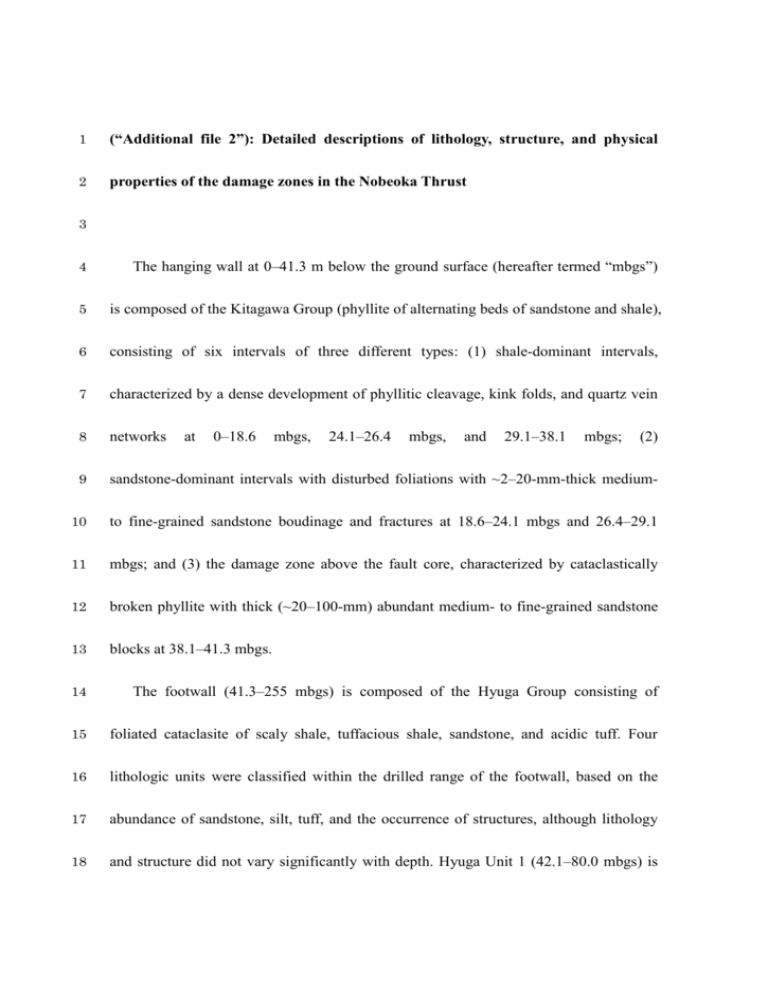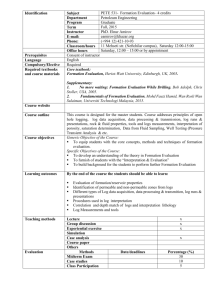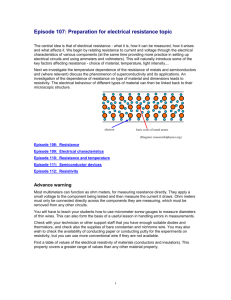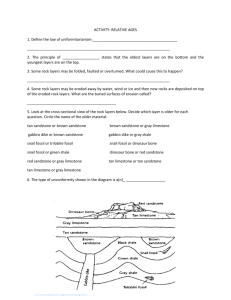Additional file 2 - Earth, Planets and Space
advertisement

1 (“Additional file 2”): Detailed descriptions of lithology, structure, and physical 2 properties of the damage zones in the Nobeoka Thrust 3 4 The hanging wall at 0–41.3 m below the ground surface (hereafter termed “mbgs”) 5 is composed of the Kitagawa Group (phyllite of alternating beds of sandstone and shale), 6 consisting of six intervals of three different types: (1) shale-dominant intervals, 7 characterized by a dense development of phyllitic cleavage, kink folds, and quartz vein 8 networks 9 sandstone-dominant intervals with disturbed foliations with ~2–20-mm-thick medium- 10 to fine-grained sandstone boudinage and fractures at 18.6–24.1 mbgs and 26.4–29.1 11 mbgs; and (3) the damage zone above the fault core, characterized by cataclastically 12 broken phyllite with thick (~20–100-mm) abundant medium- to fine-grained sandstone 13 blocks at 38.1–41.3 mbgs. at 0–18.6 mbgs, 24.1–26.4 mbgs, and 29.1–38.1 mbgs; (2) 14 The footwall (41.3–255 mbgs) is composed of the Hyuga Group consisting of 15 foliated cataclasite of scaly shale, tuffacious shale, sandstone, and acidic tuff. Four 16 lithologic units were classified within the drilled range of the footwall, based on the 17 abundance of sandstone, silt, tuff, and the occurrence of structures, although lithology 18 and structure did not vary significantly with depth. Hyuga Unit 1 (42.1–80.0 mbgs) is 19 characterized by random-fabric cataclasite and foliated cataclasite with abundant 20 fragmented sandstone and tuffacious silt blocks. Hyuga Unit 2 (80.0–112.0 mbgs) 21 consists of foliated cataclasite containing elongated blocks of sandstone and tuffacious 22 silt. Hyuga Unit 3 (112.0–180.0 mbgs) consists of foliated cataclasite with especially 23 abundant tuff. Hyuga Unit 4 (180.0–255.0 m) is composed of foliated cataclasite with 24 sandstone and tuffacious silt blocks and boudinaged sandstone layers. These lithological 25 differences are clearly detected in the geophysical logging signatures of resistivity, 26 natural gamma rays, neutron porosity, and P-wave velocity (see Fig. 2 in the main text). 27 The footwall Hyuga Units 1 and 2 show lower resistivity (~232, ~226 m) and higher 28 porosity (~7.6%). Hyuga Unit 3 is characterized by a gradual increase in resistivity 29 (~280 m,), whereas in Hyuga Unit 4, the resistivity gradually decreases (~234 m). 30 These contrasts in physical properties across the lithologic units can be clearly seen in 31 the cross-correlation of porosity and resistivity (see Fig. 12 in the main text). The 32 regional dip of bedding and cleavage in footwall Hyuga Unit 1 is approximately 30° 33 toward the SE, but the orientation of structures is more scattered compared to the 34 hanging wall. Bedding- (cleavage)-parallel fractures, faults, and mineral veins and 35 structures striking SW and dipping to the NE are dominant in Unit 1. Bordering the 36 fracture zone at 73.0–80.0 mbgs, the orientation of fractures, faults, and mineral veins in 37 Unit 2 is more scattered compared to Unit 1. Bordering the fracture zone at 112.1–115.0 38 mbgs, the regional dip of bedding (cleavage), fractures, faults, and mineral veins in Unit 39 3 is approximately 30° toward the TN and strikes SSW to SSE. The overall orientation 40 of the structures is similar, and structures striking NW to NE occur only sporadically. In 41 Unit 4, the regional dip of bedding (cleavage), fractures, faults, and mineral veins in the 42 footwall is about 30–80° toward the NE and strikes SW to SSE. Sporadically, strike 43 directions to the SE, NW, and NE are also present. Bounded by the fault at ~242 mbgs, 44 structures below this depth dip 40–80° toward the NW to NE, with strike directions of 45 SE to SW. 46 Within the drilled range of the Nobeoka Thrust, seven sets of damage zones were 47 found in the hanging wall and footwall. The hanging wall damage zone just above the 48 fault core is characterized by cataclastically broken phyllite with thick (~20–100 mm) 49 abundant medium- to fine-grained sandstone blocks at 38.1–41.3 mbgs. The footwall 50 consists of six fracture zones within each lithologic unit (66.77–85.7 mbgs, 95.0–124.0 51 mbgs, 134.1–174.0 mbgs, 184.6–196.6 mbgs, 201.8–221.2 mbgs, and 222.5–247.3 52 mbgs), all of which include a brecciated zone intensively broken in the center 53 (75.1–80.0 mbgs, 112.1–115.0 mbgs, 157.0–159.0 mbgs, 188.1–189.0 mbgs, 54 210.0–212.0 mbgs, and 242.0–243.0 mbgs), sandwiched by a surrounding damage zone 55 with abundant cohesive faults, mineral veins, and sandstone blocks (66.7–75.0 mbgs, 56 80.1–85.7 mbgs, 95.0–112.0 mbgs, 115.1–124.0 mbgs, 134.1–156.9 mbgs, 159.1–174.0 57 mbgs, 184.6–188.0 mbgs, 189.1–196.6 mbgs, 201.8–209.9 mbgs, 212.1–221.2 mbgs, 58 222.5–241.9 mbgs, and 243.1–247.3 mbgs). These fracture zones were observed in both 59 cores and borehole images, and thus are not likely to be drilling-induced structures. In 60 this document, we describe lithology, structure, and geophysical logging data for each 61 damage zone in detail. 62 Note that the electric resistivity data presented in the supplementary material 63 describe the short-normal (SN) resistivity of the shorter distance between the electrodes 64 and the long-normal (LN) resistivity of the longer distance between the electrodes, two 65 of the three types of vertical electric resistivity data obtained in this project 66 (Supplementary Material “Additional file 1”). 67 68 11.5–41.3 mbgs: Hanging wall damage zone and fault core 69 At 0–29 mbgs, the number distribution of faults, fractures, and mineral veins 70 increases with depth, with a peak at ~30 mbgs. Faults are abundant with several 71 brecciated zones (10.00–10.86 mbgs, 11.50–11.84 mbgs, and 15.35–15.52 mbgs), which 72 are in the shale-dominated intervals of dense phyllitic cleavage. Within this interval, LN 73 resistivity increases from 274 Ω m to 579 Ω m, and SN resistivity increases from 180 Ω 74 m to 600 Ω m. Below 30 mbgs and toward the fault core, the structures are more 75 disturbed and cataclastic fragmentation of sandstone is more significant, characterized 76 by a decrease in resistivity (LN: 362 Ω m, SN: 282 Ω m). At 39–40 mbgs (just above 77 the fault core), the resistivity decreases to its lowest value (LN: 235 Ω m, SN: 140 Ω m), 78 and at 40.0–41.3 mbgs (just above the fault core or the upper fault core), the values 79 (LN: 297–315 Ω m, SN: ~233 Ω m) become stable. Within the damage zone, porosity 80 (~3.5%) begins to increase significantly at 39.5 mbgs. 81 82 66.7–85.7 mbgs: Footwall fracture zone at 70.9–83.9 mbgs 83 At 76 mbgs, high porosity up to 10.0–14.3%, P-wave velocities as lowt 76 mbgs, 84 high porosity up to 10.0–14.3%, P-wave velocities as low as 3.4 km s-1, and low 85 resistivity (LN: 232 Ω m, SN: 124 Ω m) at 78 mbgs. The brecciated zones have a low 86 density of described structures due to poor core recovery, but above and below the 87 brecciated zones, faults, fractures, and mineral veins are abundant at 73–75 mbgs and 88 80–81 mbgs. Above the fracture zone (64–71 mbgs), foliated cataclasite with elongated 89 sandstone and tuffacious, siliceous blocks, boudinage, and fragments are present. Faults 90 increase toward the fault zone with cataclastic fragmentation along the faults. Sharp and 91 high-angle faults with carbonate veins are characteristic, especially at ~64 mbgs. At 92 71–75 mbgs, cohesive faults increase within the foliated cataclasites and are often filled 93 by 0.3–1.0-cm-thick mineral veins of quartz and calcite. At ~71 mbgs, resistivity 94 fluctuates and reaches a local peak (LN: 365 Ω m, SN: 338 Ω m), then rises once again 95 (LN: 299 Ω m, SN: 244 Ω m) at ~80 mbgs. Within the fracture zone, porosity begins to 96 increase significantly with a decrease in resistivity from 7–8% at 73.5 mbgs (7.8%, SN: 97 271 Ω m) and 79.1 mbgs (8.3%, SN: 203 Ω m). The values for resistivity, P-wave 98 velocity, density, and porosity in the surrounding damage zones (~240 Ω m, ~4.3 km s-1, 99 ~2.71 g cm-3, ~7.8%), the brecciated zones (~166 Ω m, ~3.9 km s-1, ~2.65 g cm-3, 100 ~10.9%), and the intact zones (~232 Ω m, ~4.3 km s-1, ~2.71 g cm-3, ~7.6%) are shown 101 in Fig. 8 in the main text. 102 103 104.8–125.8 mbgs: Footwall fracture zone at 107.2-119.9 mbgs 104 Structures are highly brecciated at 112–115 mbgs, and though the brecciated zones 105 have a low density of described structures due to poor core recovery, the number 106 distribution of cohesive structures is high at 95–104 mbgs and 115–124 mbgs above and 107 below the brecciated zone. Disturbed foliation with fragmentation and elongated 108 sandstone blocks are intercalated between the fault breccias. At 115–116 mbgs, 109 sandstone-rich foliated cataclasites are characterized by frequent faults with cataclasites 110 of fine-grained clasts, bordering densely foliated zones. At 119–121 mbgs, 111 random-fabric cataclasites and blocks of tuffacious/siliceous sandstone become 112 abundant below the fault at ~121 mbgs. Below this fault, foliated cataclasites with thick 113 blocks or thin siliceous/tuffacious sandstone layers are characteristic at 122–123 mbgs. 114 At 123–126 mbgs, zones of well-fragmented and elongated cataclasites with disturbed 115 foliations are frequently cut by faults. At 112–113 mbgs, LN and SN resistivities 116 decrease (LN: ~187 Ω m, SN: ~68 Ω m), but rise again (LN: 398 Ω m, SN: 328 Ω m) at 117 119.5 mbgs. The temperature gradient in this fracture zone is ~27.5°C km-1, which is 118 higher than the gradients of all other units in the footwall. Above the fracture zone, the 119 resistivity and S-wave velocity increase, with a peak (LN: 343.6 Ω m, SN: 284.6 Ω m, 120 2.01 km s-1) at 102–107.5 mbgs. Within the fracture zone, porosity begins to increase 121 significantly with a decrease in resistivity from ~7–9% (~6.9%, SN: 169 Ω m) near 122 111.6 mbgs and (~9%, SN: 154 Ω m) near 115.5 mbgs. The values for resistivity, 123 P-wave velocity, density, and porosity in the surrounding damage zones (~251 Ω m, 124 ~4.2 km s-1, ~2.70 g cm-3, ~7.6%), the brecciated zone (~79 Ω m, ~2.3 km s-1, ~2.08 g 125 cm-3, ~30.9%), and the intact zone (~226 Ω m, ~4.2 km s-1, ~2.7 g cm-3, ~7.6%) are 126 shown in Fig. 8 in the main text. The fracture zone at 107.2–119.9 mbgs contains the 127 most intensive brecciated zone, which may be due to the lithologic boundary where 128 abundant tuffacious and siliceous siltstone and sandstone appear and are intercalated 129 within the foliated cataclasite. The orientation of the structures also changes quite 130 markedly across the fracture zone (107.2–119.9 mbgs). The approximate curve of the 131 cross-plot between porosity and resistivity is also different below this lithologic 132 boundary (see Fig. 7 in the main text). 133 134 134.1–179.7 mbgs: Footwall fracture zone at 144.8–174 mbgs 135 Another fracture zone is found at 154.7–159.4 mbgs, which includes a brecciated 136 zone at 157–159 mbgs. The LN and SN resistivities exhibit low values (LN: 258 Ω m, 137 SN: 145 Ω m). The highly brecciated zones have a low density of described structures 138 due to poor core recovery, but note that above and below the breccias, structures are 139 concentrated, especially at 142–143 mbgs, 154–157 mbgs, and 162–170 mbgs. At 140 134–144 mbgs, sandstone blocks become relatively larger and more abundant within the 141 foliated cataclasites toward the fracture zone, with a higher occurrence of faults and 142 other structures. These foliated cataclasites continue at 144–155 mbgs, but with more 143 abundant and finer tuffacious and siliceous sandstone. Near the brecciated zone, 144 high-angle faults and mineral veins are frequent, and sandstone blocks and boudinages 145 are intercalated between the breccias. Below the breccias, foliation is disturbed, and 146 mud-rich zones increase at 160–164 mbgs. Several brecciated zones are found with 147 increasing numbers of sandstone blocks within the cataclasites at 164–174 mbgs, and 148 tuffacious, siliceous sandstone and siltstone increase from 174–180 mbgs. Below the 149 fracture zone at 152–156 mbgs, peaks are observed in LN and SN resistivities (~495 Ω 150 m) at ~170 mbgs, S-wave velocity (2.1 km s-1) at ~174.7 mbgs, and P-wave velocity 151 (4.69 km s-1) at ~171.4 mbgs. Within the fracture zone, porosity begins to increase 152 significantly with a decrease in resistivity at 153.2 mbgs (6.9%, SN: 365 Ω m) and 153 160.2 mbgs (6.6%, SN: 331 Ω m). The values for resistivity, P-wave velocity, density, 154 and porosity in the surrounding damage zones (~330 Ω m, ~4.4 km s-1, ~2.71 g cm-3, 155 ~7.2%), the brecciated zone (~168 Ω m, ~4.0 km s-1, ~2.65 g cm-3, ~10.9%), and the 156 intact zone (~280 Ω m, ~4.3 km s-1, ~2.72 g cm-3, ~7.2%) are shown in Fig. 8 in the 157 main text. 158 159 180.9–198.4 mbgs: Footwall fracture zone at 184.6–196.6 mbgs 160 At ~188 mbgs, the number distribution of fractures, faults, and mineral veins 161 increases as the foliation becomes disturbed, and cohesive faults are abundant within the 162 foliated cataclasites consisting of sandstone clasts. Tuffacious sandstone is abundant, 163 especially at 182–183 mbgs, but the occurrence of coarser sandstone increases with 164 more frequent faults and veins. A highly brecciated zone is present at 197–199 mbgs, 165 where the number distribution of described structures is lower. Foliated cataclasite with 166 fragmented and elongated sandstone is characteristic, and structures including faults are 167 abundant near the brecciated zone. At 188–189 mbgs, the fracture zone is characterized 168 by a slight increase in neutron porosity up to 9.2%, a peak in S-wave velocity (1.95 km 169 s-1) at 194.9 mbgs, a low in SN resistivity (199.4 Ω m) at 188.5 m, followed br the 170 brecciated zone. At 188–189 mbgs, the fracture zone is characterized by a slight 171 increase in neutron porosity up to 9.2%, a peak in S-wave velocity (1.95 km s-1) at r the 172 brecciated zone. At 188–189 mbgs, the fracture zone is characterized by a slight 173 increase in neutron porosity up to 9.2%, a peak in S-wave velocity (1.95 km s-1) at 174 194.9 mbgs, a low in SN resistivity (199.4 Ω m) at 188.5 m, followed by an increase to 175 299.6 Ω m at 194.5 mbgs. In subunit 4-1 (180–210 mbgs), the spontaneous potential 176 increases sharply with a sharp linear slope of ~1090 V km-1, which is unique for this 177 subunit. Within the fracture zone, porosity begins to increase significantly with a 178 decrease in resistivity at 187.5 m (~7.1%, SN: 229 Ω m) and 189.9 m (6.5%, SN: 234 Ω 179 m). The values for resistivity, P-wave velocity, density, and porosity in the surrounding 180 damage zones (~270 Ω m, ~4.5 km s-1, ~2.73 g cm-3, ~6.7%), the brecciated zone (~205 181 Ω m, ~4.1 km s-1, ~2.69 g cm-3, ~8.4%), and the intact zone (~255 Ω m, ~4.4 km s-1, 182 ~2.72 g cm-3, ~7.1%) are shown in Fig. 8 in the main text. 183 184 199.5–235.9 mbgs: Footwall fracture zone at 201.8–221.2 mbgs 185 Tuff and tuffacious/siliceous sandstone layers are abundant at 204–206 mbgs, and 186 below 207–225 mbgs, the number of faults, fractures, and mineral veins increases with 187 peaks at ~215 mbgs and ~220 mbgs. Within this zone, there is a highly brecciated 188 interval at 210-212 mbgs, characterized by a peak in neutron porosity (14.7%) and lows 189 in LN and SN resistivity (287 Ω m and 182 Ω m, respectively). Brecciated areas are 190 occasionally seen at 214-217 mbgs and 219-220 mbgs with deformed cataclasites 191 accompanied by abundant sandstone and siliceous fragments. At 221–222 mbgs, 192 tuffacious, siliceous sandstone is characteristic, followed by fragmented and boudinaged 193 sandstone. At 220–230 mbgs, faults and mineral veins are abundant, and LN and SN 194 resistivities increase to 468 Ω m and 463 Ω m, respectively. Foliated cataclasites with 195 elongated sandstone or silt/tuffacious blocks occasionally accompany boudinage and 196 disturbed foliation. Within the fracture zone, porosity begins to increase significantly 197 with a decrease in resistivity at 209.8 m (~6.1%, SN: 314 Ω m) and 212.2 m (6.9%, SN: 198 216 Ω m). The values for resistivity, P-wave velocity, density, and porosity in the 199 surrounding damage zones (~281 Ω m, ~4.3 km s-1, ~2.72 g cm-3, ~7.0%), the 200 brecciated zone (~209 Ω m, ~3.6 km s-1, ~2.59 g cm-3, ~9.4%), and the intact zone 201 (~282 Ω m, ~4.6 km s-1, ~2.71 g cm-3, ~6.4%) are shown in Fig. 8 in the main text. 202 203 215.2–252 mbgs: Footwall fracture zone at 225.6–247.3 mbgs 204 At 240–255 mbgs, cataclastic fragmentation of sandstone clasts is abundant within 205 the foliated cataclasite. Faults, fractures, and mineral veins increase at 239–242 mbgs, 206 followed by a brecciated zone at 242–243 mbgs. At 240–255 mbgs, foliation is 207 disturbed with elongated, boudinaged structures, and cataclastic fragmentation of 208 sandstone clasts is abundant within the foliated cataclasites. At ~250 mbgs, high-angle 209 faults border high-angle and low-angle foliations. The number distribution of structures 210 increases at 252–253 mbgs. At 251–254 mbgs, a low-angle disturbed foliated zone with 211 abundant elongated sandstone clasts and fragmentation can be seen. At 240–242 mbgs, 212 neutron porosity rises to 13.5%, with low LN and SN resistivities (170 Ω m and 90 Ω m, 213 respectively). P-wave velocity, S-wave velocity, and LN and SN resistivities decrease 214 towards the fracture zone at 240–242 mbgs, but increase slightly at 247 mbgs (P-wave: 215 4.7 km s-1, S-wave: 2.0 km s-1, LN: 226 Ω m, SN: 211 Ω m). Within the fracture zone, 216 porosity begins to increase significantly with a decrease in resistivity from ~6.8%, SN: 217 175 Ω m and 8%, SN: 128 Ω m at 240.6 m. The values for resistivity, P-wave velocity, 218 density, and porosity in the surrounding damage zones (~228 Ω m, ~4.5 km s-1, ~2.73 g 219 cm-3, ~6.6%), the brecciated zone (~101 Ω m, ~3.6 km s-1, ~2.65 g cm-3, ~10.1%), and 220 the intact zones (~234 Ω m, ~4.6 km s-1, ~2.73 g cm-3, ~6.4%) are shown in Fig. 8 in the 221 main text. 222






